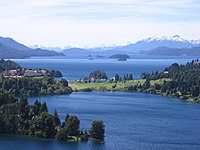
Photo from wikipedia
Abstract Cold environments represent the largest fraction of Earth's biosphere, and are known habitats for cold-adapted microorganisms. The aim of this study was to assess the occurrence and biodiversity of… Click to show full abstract
Abstract Cold environments represent the largest fraction of Earth's biosphere, and are known habitats for cold-adapted microorganisms. The aim of this study was to assess the occurrence and biodiversity of cold-adapted fungi associated with the Castano Overo glacier, Mount Tronador, Patagonia, Argentina. Samples of naked soil, glacial ice and snow were collected and analyzed using tag-encoded 454 pyrosequencing of the nuclear ribosomal internal transcribed spacer (ITS). A total of 1082 OTUs (operational taxonomic units) and 151,669 sequences were obtained. OTUs obtained from soil samples corresponded mainly to the phylum Ascomycota, whereas for snow and ice samples the phylum Basidiomycota was the most represented group. Metabarcoding analysis showed high biodiversity in glacial environments and allowed the detection of hitherto unknown taxa for Patagonia. To the best of our knowledge, this is the first report of fungal diversity in an extreme glacial environment of Patagonian Argentina using amplicon sequencing.
Journal Title: Fungal Ecology
Year Published: 2018
Link to full text (if available)
Share on Social Media: Sign Up to like & get
recommendations!